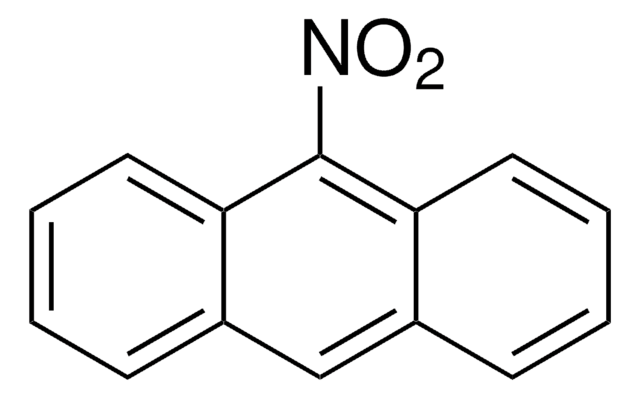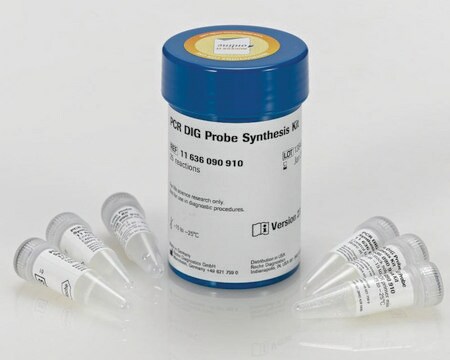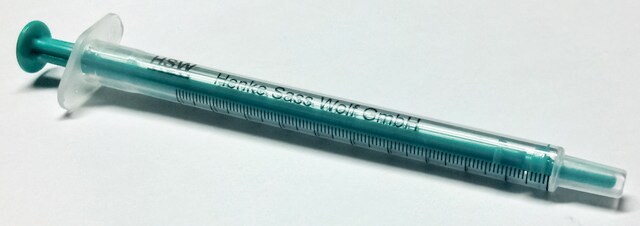PP2394
Bacterial FLAG® Tag Vector Set
plasmid vectors for molecular cloning
Synonym(e):
cloning vector, expression vector, molecular cloning vector, plasmid, plasmid vector, snapfast vector, vector
About This Item
Empfohlene Produkte
Markierung
FLAG® tagged
Form
buffered aqueous solution
Bakterienauswahl
kanamycin
Replikationsursprung
pUC (500 copies)
Peptidspaltung
TEV
no cleavage
Lage der Peptid-Tags
C-terminal
N-terminal
Promoter
Promoter name: OXB20
Promoter activity: constitutive
Promoter type: bacterial
Versandbedingung
ambient
Lagertemp.
−20°C
Allgemeine Beschreibung
This pack enables you to compare placing FLAG epitope tags at either the N or C terminus of your gene of interest (inserted into the MCS, under transcriptional control of the OXB20 strong bacterial promoter) with, and also without a TEV (Tobacco Etch Virus) protease cleavage site. The TEV site enables removal of the FLAG tag from the protein following production. Comparing these four configurations should enable you to evaluate how best to express and detect your gene of interest from bacterial cells. We also provide many other functional tags and cleavage sites, if required.This plasmid set has been designed to be compatible with a range of cloning techniques. The multiple cloning site contains a range of standard commonly used restriction sites for cloning. Using these sites genes can be inserted using standard cloning methods with DNA ligase. Other methods such as ligase independent cloning (LIC) Gibson Assembly InFusionHD or Seamless GeneArt can also be used and because all of our plasmids are based on the same backbone the same method can be used for cloning into all of our catalogue vectors.
Multiple cloning site notes: There are a few important sites within the MCS. These include the NcoI site the XbaI site and the BsgI and BseRI sites. The NcoI site contains a start codon that is immediately downstream of both a Kozak and Shine-Dalgarno ribosomal binding site. These allow for optimal positioning of genes when the start codon is placed in this location. If this is not required and you wish to use a downstream site for gene cloning you can remove the NcoI site by cleaving the plasmid with KpnI. The XbaI site contains a stop codon. This stop codon is positioned in a specific position in relation to the BsgI and BseRI sites that are immediately downstream. When either BseRI or BsgI cleave the plasmid they produce a TA overhang from the stop codon in the XbaI site that is compatible with all of our peptide tag plasmids cut with the same sites. BseRI and BsgI sites are non-palindromic and cleave a defined number of bases away from their binding site. Whenever we clone a gene into our multiple cloning site we always position the start and stop codon in the same positions in the MCS. If the start and ends of the genes are not compatible with NcoI and XbaI we extend the sequence to the nearest external sites but keep the start and stop codons locations consistent.
Transcription Termination: These plasmids contains three alternative transcription terminators for mammalian bacterial and bacteriophage (T7) expression. This means that only the promoter needs to be changed to alter the expression system you are using. We sell multiple promoters that can be used in each of these systems. The presence of each terminator does not reduce expression in the alternative systems.
Sequenz
Hinweis zur Analyse
Sonstige Hinweise
Rechtliche Hinweise
Nur Kit-Komponenten
- PSF-OXB20-NH2-FLAG®-TEV - N-TERMINAL FLAG® TAG BACTERIAL PLASMID, plasmid vector for molecular cloning
- PSF-OXB20-COOH-TEV-FLAG® - C-TERMINAL FLAG® TAG BACTERIAL PLASMID, plasmid vector for molecular cloning
Ähnliches Produkt
Lagerklassenschlüssel
12 - Non Combustible Liquids
Flammpunkt (°F)
Not applicable
Flammpunkt (°C)
Not applicable
Analysenzertifikate (COA)
Suchen Sie nach Analysenzertifikate (COA), indem Sie die Lot-/Chargennummer des Produkts eingeben. Lot- und Chargennummern sind auf dem Produktetikett hinter den Wörtern ‘Lot’ oder ‘Batch’ (Lot oder Charge) zu finden.
Besitzen Sie dieses Produkt bereits?
In der Dokumentenbibliothek finden Sie die Dokumentation zu den Produkten, die Sie kürzlich erworben haben.
Unser Team von Wissenschaftlern verfügt über Erfahrung in allen Forschungsbereichen einschließlich Life Science, Materialwissenschaften, chemischer Synthese, Chromatographie, Analytik und vielen mehr..
Setzen Sie sich mit dem technischen Dienst in Verbindung.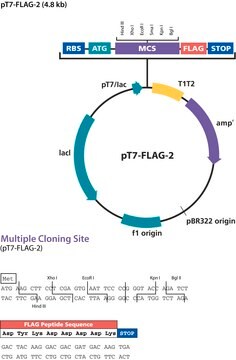

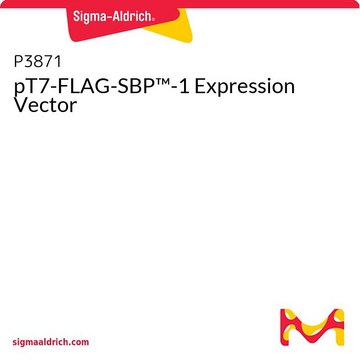
![7-Chlor-4-{[4-(ethylamino)-1-methylbutyl]amino}quinolin ≥95% (HPLC)](/deepweb/assets/sigmaaldrich/product/structures/204/316/bfb1a4ed-e5a5-40f0-9525-fe05449a41ab/640/bfb1a4ed-e5a5-40f0-9525-fe05449a41ab.png)

